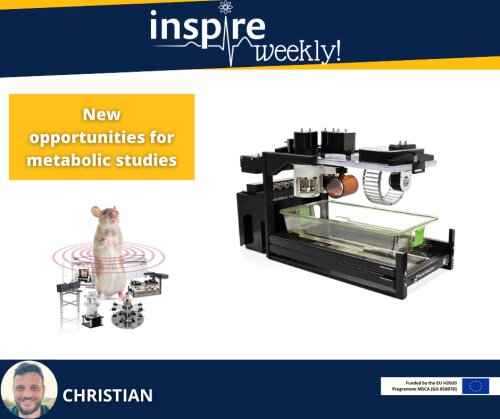03/11/2021 - Christian (ESR #4)

Telemetry technology gives researchers a high degree of flexibility and freedom to combine cardio-physiological experiments with a wide range of other experiments.
During my PhD project I will collaborate with the Wageningen University to combine telemetry with metabolic and nutritional studies. There, we will perform Indirect Calorimetry studies with the PhenoMaster (TSE Systems) platform for mice to measure whole body energy expenditure and substrate usage measured as respiratory exchange ratio1. Integrated microbiome gas sensors enable us to additionally measure (in exhaled air) the gut microbial fermentation products methane and hydrogen from indigestible foods2. This gives insights on how different nutritional treatments directly affect intestinal bacteria composition and their activity3, which influence not only gut health itself, but also brain function4.
Such metabolic studies are thus far performed in individually housed animals to quantify individual food intake, energy expenditure and other metabolic and physiological parameters. In line with the Directive 2010/63/EU we aim to house mice in pairs for animal welfare reasons. The novel Stellar telemetry implant (TSE Systems) with an integrated tracking functionality will track the mice individually and help to assign food and drink intake to each individual mouse. Furthermore, we aim to allocate the indirect calorimetry air measurements to the individual level as well.
References
- Hoevenaars, F. P., Keijer, J., Swarts, H. J., Snaas‐Alders, S., Bekkenkamp‐Grovenstein, M., & van Schothorst, E. M. (2013). Effects of dietary history on energy metabolism and physiological parameters in C57BL/6J mice. Experimental physiology, 98(5), 1053-1062. https://doi.org/10.1113/expphysiol.2012.069518
- Fernández-Calleja, J. M., Konstanti, P., Swarts, H. J., Bouwman, L. M., Garcia-Campayo, V., Billecke, N., ... & van Schothorst, E. M. (2018). Non-invasive continuous real-time in vivo analysis of microbial hydrogen production shows adaptation to fermentable carbohydrates in mice. Scientific reports, 8(1), 1-16. https://doi.org/10.1038/s41598-018-33619-0
- Breath reveals how gut bacteria process food, WUR impact story. https://www.wur.nl/en/article/breath-reveals-how-gut-bacteria-process-food.htm
- Cryan, J. F., O'Riordan, K. J., Cowan, C. S., Sandhu, K. V., Bastiaanssen, T. F., Boehme, M., ... & Dinan, T. G. (2019). The microbiota-gut-brain axis. Physiological reviews. https://doi.org/10.1152/physrev.00018.2018